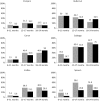Poor dietary diversity and low nutrient density of the complementary diet for 6- to 24-month-old children in urban and rural KwaZulu-Natal, South Africa
- PMID: 25138429
- PMCID: PMC6860079
- DOI: 10.1111/mcn.12146
Poor dietary diversity and low nutrient density of the complementary diet for 6- to 24-month-old children in urban and rural KwaZulu-Natal, South Africa
Abstract
Infants and toddlers have high nutritional requirements relative to body size but consume small amounts of food and therefore need nutrient-dense complementary foods. A cross-sectional study included children aged 6-24 months, stratified in three age categories (6-11 months, 12-17 months and 18-24 months) and randomly selected from an urban (n = 158) and a rural (n = 158) area, both of low socio-economic status, in the KwaZulu-Natal Province of South Africa. Dietary diversity and nutrient density of the complementary diet (excluding breast milk and formula milk) based on a repeated 24-h dietary recall was assessed. For breastfeeding children, nutrient density of the complementary diet was adequate for protein, vitamin A and vitamin C; and inadequate for 100% of children for zinc, for >80% of children for calcium, iron and niacin; and between 60% and 80% of children for vitamin B6 and riboflavin. Urban/rural differences in density for animal and plant protein, cholesterol and fibre occurred in 18-24-month-old children. Fewer than 25% of children consumed ≥4 food groups, with no urban/rural differences. Higher dietary diversity was associated with higher nutrient density for protein and several of the micronutrients including calcium, iron and zinc. The poor nutrient density for key micronutrients can probably be ascribed to lack of dietary variety, and little impact of mandatory fortification of maize meal/wheat flour on infants/toddlers' diet. Targeted strategies are needed to enable mothers to feed their children a more varied diet.
Keywords: breastfeeding; complementary foods; food and nutrient intake; infant feeding; infant formula; micronutrients.
© 2014 John Wiley & Sons Ltd.
Conflict of interest statement
The authors declare that they have no conflicts of interest.
Figures






References
-
- Acham H., Oldewage‐Theron W.H. & Egal A.A. (2012) Dietary diversity, micronutrient intake and their variation among black women in informal settlements in South Africa: a cross‐sectional study. International Journal of Nutrition and Metabolism 4, 24–39.
-
- Agostoni C., Braegger C., Decsi T., Kolacek S., Koletzko B., Michaelsen K.F. et al (2009) Breast‐feeding: a commentary by the ESPGHAN Committee on Nutrition. Journal of Pediatric Gastroenterology and Nutrition 49, 112–125. - PubMed
-
- Bhutta Z.A., Das J.K., Rizvi A., Gaffey M.F., Walker N., Horton S. et al (2013) Evidence‐based interventions for improvement of maternal and child nutrition: what can be done and at what cost? Lancet 382, 452–477. - PubMed
-
- Black R.E., Allen L.H., Bhutta Z.A., Caulfield L.E., de Onis M., Ezzati M. et al (2008) Maternal and child undernutrition: global and regional exposures and health consequences. Lancet 371, 243–260. - PubMed
MeSH terms
Substances
LinkOut - more resources
Full Text Sources
Other Literature Sources
Medical

